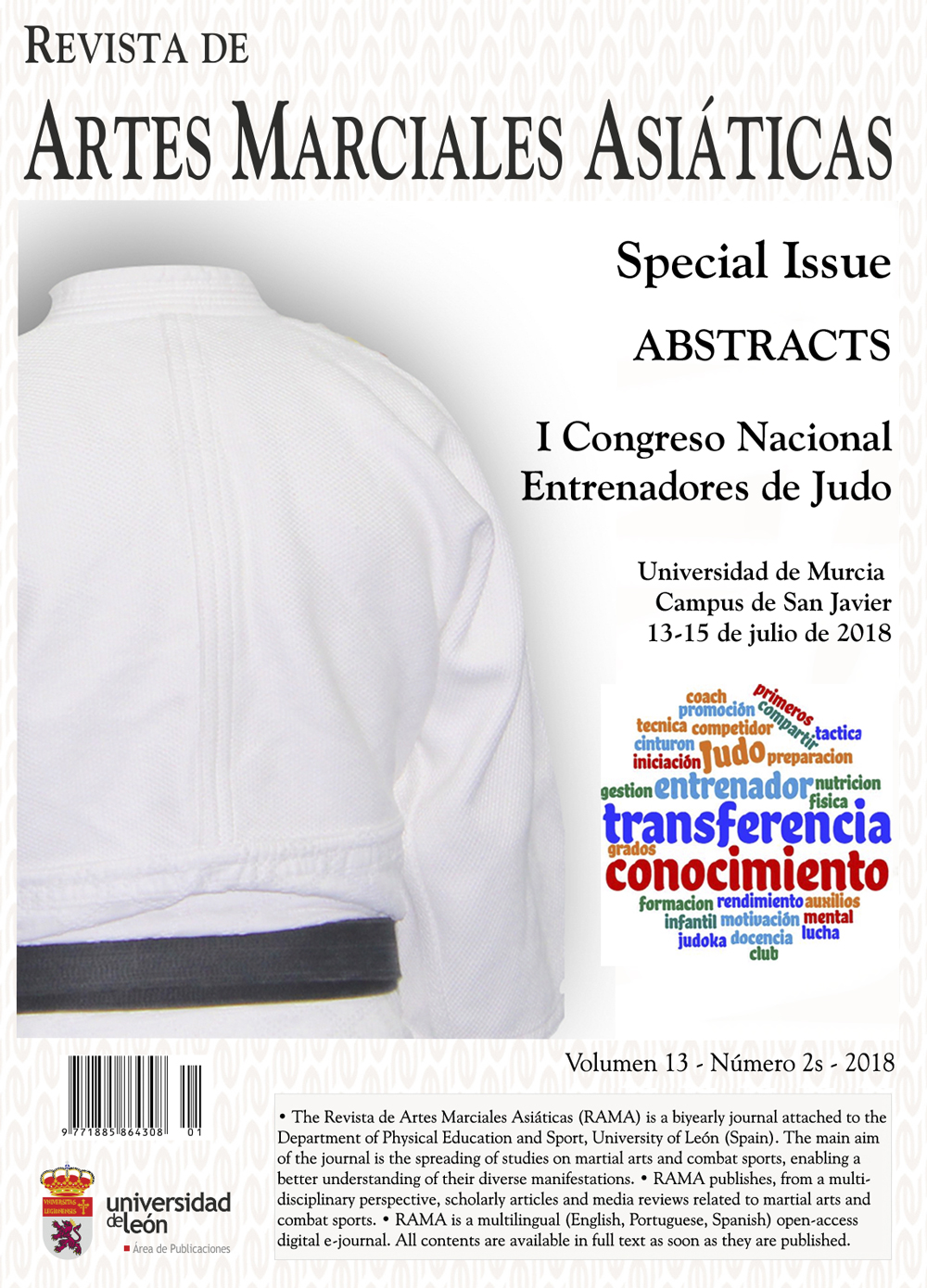Basic functional assessment of the judoka: A pilot study
DOI:
https://doi.org/10.18002/rama.v13i2s.5500Keywords:
Judo, symmetry, mobility, functional assessmentAbstract
The aim of this study was to describe the basic functional profile (VAFB) of a group of 13 competitive judokas at the national level. The method used was the basic functional Assessment tests battery proposed by Gil-López (2018). The results obtained indicate a Global Injury Risk Index (LRTI) of 45.74 ± 2.01%. The most common compensations among all judokas were external rotation of the foot, right/left, left/right foot pronation, loss of lumbo-pelvic dissociation, chest movement, winged scapulae and cervical protation. As for the years of practice, there were differences in the shoulder joint test (SM), where there was a greater number of compensations in the judoka who had been practicing judo less than ten years. Participants did not show a high risk of injury, but it is recommended to include corrective exercises to improve the judokas’ detected deficits.
Downloads
Métricas alternativas
References
Bolach, B., Witkowski, K., Piepiora, P., Sokólski, R., & Bolach, E. (2016). Injuries and overloads in combat sports exemplified by Thai boxing and judo. Journal of Combat Sports and Martial Arts, 2(2), 89-96.
Boguszewski, D., Adamczyk, J.G., Buda, M., Kłoda, M., & Białoszewsk, D. (2016). The use of functional tests to assess risk of injuries in judokas. Archives of Budo, 12, 56-62.
Boguszewski, D., Buda, M., Adamczyk, J.G., Boguszewska, K., Obszynska-Litwiniec, A., & Białoszewsk, D. (2014). Chronic pain in the musculoskeletal system among judo athletes. Journal of Combat Sports and Martial Arts, 2(2): 77-82.
Castropil, W., & Arnoni, C. (2014). Postural patterns and adaptations in judo athletes. Archives of Budo, 10, 23-28
Chapman, R. F., Laymon, A. S., & Arnald, T. (2014). Functional Movement Scores and Longitudinal Performance Outcomes in Elite Track and Field Athletes. International Journal of Sports Physiology and Performance, 9, 203-211. doi: http://doi.org/10.1123/ijspp.2012-0329
De Blaiser, C., Roosen, P., Willems, T., Danneels, L., Vanden, L., & De Ridder, R. (2018). Is core stability a risk factor for lower extremity injuries in an athletic population? A systematic review. Physical therapy in sport, 30, 48-56. doi: http://doi.org/10.1016/j.ptsp.2017.08.076
Detanico, D., dal Pupo, J., Franchini, E., Fukuda, D. H., & dos Santos, S. G. (2017). Effects of traditional judo training session on muscle damage symptoms. Journal of Sports Medicine and Physical Fitness, 57(6), 872-878. doi: http://doi.org/10.23736/S0022-4707.16.06320-9
Gil-López, M. I. (2018). Valoración Funcional Básica. Propuesta y justificación a través de la metodologia observacional (Trabajo de máster). Facultad ciencias del deporte, Universidad de Murcia, Murcia, España.
Hides, J. A., Oostenbroek, T., Smith, M. M. F., & Mendis, M. D. (2016). The effect of low back pain on trunk muscle size/function and hip strength in elite football (soccer) players. Journal of sports sciences, 34(24), 2303-11. http://doi.org/10.1016/j.jsams.2017.01.049
Downloads
Published
How to Cite
Issue
Section
License
Copyright (c) 2018 María Isabel Gil-López, Mateo García-Hurtado, Raquel Hernández-García

This work is licensed under a Creative Commons Attribution-NonCommercial-ShareAlike 4.0 International License.
The authors who publish in this journal must agree to the following terms:
- The authors grant on a nonexclusive basis the exploitation rights (reproduction, distribution, public communication and transformation) of the work accepted for publication to the University of León. The authors can establish, on their own, additional agreements for the non-exclusive distribution of the version of the work published in the journal (for example, placing it in an institutional repository or publishing it in a book), always acknowledging the initial publication in this journal.
- This work is licensed under the Creative Commons Attribution-NonCommercial-ShareAlike 4.0 International License. Click to see basic information and the legal text of the license.
- The authors are allowed and encouraged to disseminate electronically pre-print or post-print versions of their work before publication, as this can give rise to productive exchanges, as well as earlier and increased citing of the works published.











